By the early 1980s, aviation had become an expensive hobby for anyone who could not justify the ownership of a certified aircraft. A large number of pilots had become disenfranchised through the limited availability of a cost effective, “fun-to-fly” and “practical-to-own” airplane. The kit aircraft was conceived as an alternative to high-hour, used aircraft, “plans-built” airplanes, which were impractical for all but a small percentage of would-be builders, and restorations, which were limited in availability and often required as much work and specialized skills as building from plans.
Denney Aerocraft produced the first Kitfox kit in November of 1984 in a small factory in Boise, Idaho. The Kitfox was designed as a lightweight, two-place sport aircraft with excellent STOL (Short Takeoff and Landing) performance and the ability to operate from short and unimproved airfields. The Kitfox features folding wings and is easily trailered, allowing owners to share hangar space or keep their Kitfox's at home in a single car garage. Six Model 1 Kitfox's were delivered that first year. Since 1984, over 4,000 Kitfox kits have been delivered to builders throughout the United States, Canada, and over 42 foreign countries. Under Dan Denney’s leadership, the Kitfox evolved from the original Model 1 to continually improved versions referred to as the Models 2, 3, 4, and Classic 4.
In June 1992, SkyStar Aircraft Corporation, under the direction of Phil Reed, purchased the rights to produce the Kitfox kit from Denney Aerocraft. SkyStar immediately began development of a completely new Kitfox, the Series 5. This larger aircraft was designed to fit the needs of a growing segment of the marketplace that wanted a “Weekend Cruiser.” These pilots wanted a recreational airplane that combined the best attributes of the Kitfox with greater useful loads, certified engines, increased cabin space, and larger cargo capacity. The Series 5, which offered both a Taildragger (the Outback/Safari) and tri-gear (the Vixen/Voyager) configuration, answered these requests and became one of the most successful introductions in the history of the kit plane industry.
In January of 2000, an employee group acquired SkyStar Aircraft, and an exciting new chapter began for the SkyStar team. SkyStar announced the new Kitfox Series 6, an airplane that incorporated all of the best features of all versions of the Series 5. The Series 5 evolved into the Series 6, and now the new Series 7.
In 2000, SkyStar introduced the Kitfox Lite Squared as a two-place companion to the single-place Kitfox Lite. The Lite Squared was a reconfigured version of the Kitfox Classic 4, and rapidly gained popularity in the ultralight community. The Lite Squared also seemed to be the “poster child” for the newly proposed Sport Pilot regulations, but time changed that viewpoint. The Kitfox Series 7 was finally selected as SkyStar's entrant into the Sport Plane market. With the implementation of Sport Pilot regulations, the ultralight trainer category of airplane was eliminated, resulting in the discontinuation of the Lite Squared version of the Classic 4.
In 2002, SkyStar introduced the new, high performance, Kitfox Series 7, and the image of the Kitfox was forever changed. With cruise speeds of up to 160 mph, and a service ceiling above 25,000 feet, it became clear that the Kitfox could no longer be classified as a “low and slow” airplane. It soon became evident that the Series 7 was better adapted to the Sport Plane regulation than was the Lite Squared. A short-lived “Sport Plane” version of the Series 7 was introduced to address the EAA and FAA publicity surrounding Sport Plane. As understanding of the proposed Sport Plane rule matured, however, it became clear that the specially packaged version of the Kitfox Series 7, known as the Kitfox Sport, would not be needed, and all Sport Pilots would be delighted to learn that all three Kitfox airframes now in production (Lite, Classic 4, and Series 7) meet the Sport Plane definition.
In General Aviation, the Kitfox has become synonymous with quality, value, and performance. As a pioneer of the kit industry, the Kitfox has set standards for kit quality and completeness, technical documentation, and builder support that are second to none.
After 20 years of manufacturing the Kitfox, and worldwide deliveries into 42+ countries, we continue to refine one of the best aircraft kits in the marketplace. After diversifying into ultralight and ultralight training worlds, and leading the pack for the upcoming Sport Pilot world; now, stand by for speed!
Model 1 (1984) Serial #1-257 (Out Of Production)
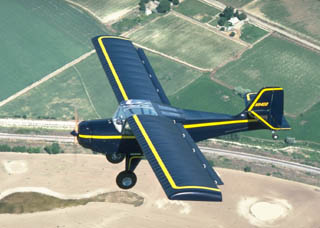
The Kitfox Model 1 introduced the nostalgic “bump” cowl that has become the signature of the Kitfox. This cowl design was originally intended to accommodate a small radial engine, but the engine intended for the Kitfox never matured. The “round engine” look was retained, and remains popular today. The compact Model 1 had an empty weight of only 425 pounds, and a gross weight of 850 pounds. The Rotax 532 was the engine of choice, although other two-stroke engines have been used.
From a flying standpoint, the Kitfox Model 1 would be called an ultralight by today’s standards. It is a very simple, basic airplane that is light weight and relatively high powered (usually 65 HP). The interior can best be described as “cozy,” and the aircraft was usually built without dual brakes. The Model 1 accelerates rapidly and has light ailerons. There is a good deal of adverse yaw coupled with a neutral yaw axis. The adverse yaw is easily taken care of with rudder, but the rudder feel is different than most contemporary airplanes. Basically, if you push the rudder to yaw the plane, it will stay yawed. You may have to physically move the rudder to bring the nose back to the center. It takes time to adapt to this characteristic, but it is easily learned. The flaperons may be moved as flaps to affect pitch trim and lower the stall speed. Lowering the flaperons to more than 2/3 of their full travel will result in up to a 50% reduction in roll rate. Takeoffs and landings are quite normal for a tailwheel airplane and easier than most. The nose fuel tank keeps most of the mass (center of gravity) right along the centerline, and directional control is not a major challenge. (Return to Top)
Gross weight 850 lbs. Average cruise speed 75 mph Stall Speed 36 mph Average empty weight 426 lbs. Average useful load 424 lbs. Max speed (Vne) 100 mph Cabin width 36 in. Wing span 32 ft. Length (wings folded) 21 ft. Width (wings folded) 7 ft. 10 in. Height 67 in.
Model 2 (1989) Serial #258-748 (Out Of Production)

The larger, wider Kitfox Model 2 was introduced in 1989. This “beefier” Kitfox allowed for greater useful loads and more room in the cabin. The Model 2 featured a larger vertical tail area and the new Rotax 582 engine option. The gross weight was increased to 950 pounds. The airfoil and control systems remained the same as the Model 1, but spars were strengthened to accommodate the higher gross weight.
Flying-wise, the Kitfox Model 2 is quite similar to the Model 1. The larger tail surface helped some with the yaw issues, but was somewhat offset by larger engines and the introduction of wing tanks. Like the Model 1, the Model 2 is yaw neutral and needs to have the nose “placed” where it needs to be. Flaperon use and characteristics are virtually identical to the Model 1. Dual brakes were available for late Model 2 airplanes, and many earlier Model 2 airplanes have had dual brakes installed. Ground handling is similar to the Model 1, but the increase in gross weight, therefore greater mass, does cause one to pay a bit more attention to the landing rollout. (Return to Top)
| Gross weight | 950 lbs. |
| Average cruise speed | 85 mph |
| Stall Speed | 36 mph |
| Average empty weight | 426 lbs. |
| Average useful load | 524 lbs. |
| Max speed (Vne) | 100 mph |
| Cabin width | 39.5 in. |
| Wing span | 32 ft. |
| Length (wings folded) | 21 ft. 1 in. |
| Width (wings folded) | 7 ft. 10 in. |
| Height | 67 in. |
Model 3 (1990) Serial #749-1215 (Out Of Production)
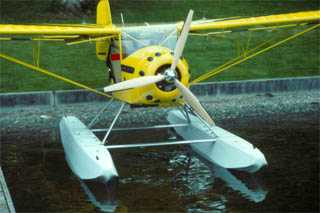
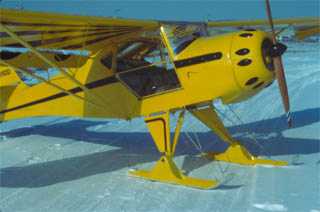
The Kitfox Model 3 featured structural changes that were designed to improve flight characteristics and provide a better platform for more powerful engines like the new 80 HP Rotax 912. A larger vertical stabilizer and rudder were added, as well as larger, stronger lift struts and spar carry through tubes in the fuselage. The gross weight was increased to 1050 pounds, but the empty weight only went up by a few pounds. This was the last Kitfox to use the original airfoil and flight control system introduced on the Model 1.
The Model 3 was the first major attempt to aggressively deal with the yaw control issue. It should be remembered that we are not talking about yaw instability, but a neutral yaw condition. In other words, it was desired to have the airplane return to straight flight after pressing a rudder without having to move it back with your feet. Much of this objective was achieved by increasing the size of the vertical fin. The flaperon system is identical to the Model 1 and Model 2, with very similar handling characteristics. Again, the higher gross weight requires one to practice at least average tailwheel skills. (Return to Top)
| Gross weight | 1050 lbs. |
| Average cruise speed | 85 mph |
| Stall Speed | 37 mph |
| Average empty weight | 460 lbs. |
| Average useful load | 590 lbs. |
| Max speed (Vne) | 100 mph |
| Cabin width | 39.5 in. |
| Wing span | 32 ft. |
| Length (wings folded) | 21 ft. 1 in. |
| Width (wings folded) | 7 ft. 10 in. |
| Height | 67 in |
Model 4-1050 Serial #1400-1722 (Out Of Production)

Introduced at Oshkosh in 1991, the Kitfox Model 4 was a completely new aircraft featuring innovations that enhanced the STOL abilities, improved flight handling and stability, and increased top speed by 10 to 15%. The Model 4 featured a new higher speed, laminar flow airfoil, new flaperon design, metal flaperon attach brackets, and a brand new 2:1 differential aileron control system that allows much improved control at full flaps. The gross weight of the Kitfox Model 4-1050 was the same as the Model 3, 1,050 pounds. The Model 4 is an ideal platform for the Rotax 912 series of engines but is equally suitable for two-stroke engines.
From a flying standpoint, the Kitfox Model 4-1050 was a genuine attempt to make the Kitfox handle like a contemporary, certified airplane, without losing the heritage of agility. It worked. The new airfoil added speed and performance. The flaperon airfoil, area, placement and movement ratios were changed significantly. For the first time, the flaperon moving up traveled twice as far as the flaperon moving down. This is similar to a Piper Cherokee. Rudder coordination was made much easier. The flaperons continued to be used for climb and cruise pitch trim, and back pressure is required to maintain approach speed. While reduction of roll rate was not as pronounced, the use of full flaperons did reduce the roll by up to 30% and increased the stick loads. The vertical fin area remained the same as the Model 3, once again a bit small for the larger engines now being installed. While yaw stability was no longer neutral, it was not aggressively positive. It would take one more iteration to get yaw stability to a more contemporary feel. (Return to Top)
Model 4-1200 (Classic IV) Serial #1723- (Still in production)
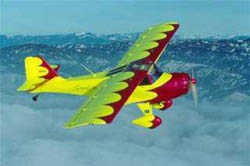
The Kitfox Model 4-1200, currently marketed under the name of the Kitfox Classic 4, is the final evolution of the original Denney Aerocraft Kitfox design that began in 1984. One of the most successful kits on the market today, the Classic 4 kit has been sold continuously since late 1991. The Classic 4 has heavier lift struts and gear legs, as well as beefed up carry through tubes in the fuselage, to allow for a higher gross weight than the earlier Model 4 kits. The height of the vertical stabilizer and rudder was increased by 10 inches, and the rudder depth was increased by 2 inches to allow for improved handling. The Classic 4 is also available in a short wing Speedster configuration for those wishing more speed and a higher roll rate.
In 1994, a light weight version of the Classic 4 was introduced with a Rotax 503 as the standard power plant. This airplane, known as the Kitfox XL, qualified as an ultralight trainer, but did not gain market popularity. In 2001, an upgraded version of the Kitfox XL was introduced as the Kitfox Lite Squared and met with instantaneous market success. The Kitfox Classic 4 remains suitable for both the two-stroke and four-stroke Rotax 912 engine series. Many other engines have been adapted to the Kitfox Classic 4.
Not only is the Kitfox Model 4 (Classic 4, Speedster, Lite Squared) the final evolution of the original Denney Aerocraft concept in terms of structure and engineering, but it is the best flying of all the previous versions. The vertical surfaces were increased significantly, resulting in excellent, positive, yaw stability. The Speedster version of the Model 4 added aerodynamic enhancements to the empennage, including an electric trim tab. Speedster modifications can be used on any Model 4 variant. Handling is smooth and crisp. While rudder coordination is needed, it is much closer to what most pilots encounter in today’s modern training airplanes.
The higher gross weight and larger wing fuel tanks cause one to pay attention on landing rollout, but the much larger vertical tail surface gives you all the control power needed, and then some. The available electric pitch trim allows the Model 4 (in all its variations) to be trimmed for hands off flight in almost all normally anticipated flight attitudes. Many Model 4 aircraft were equipped with the 4-cylinder, 4-stroke, Rotax 912 that produces 80 HP. Model 4 variants are now turning up with the 100 HP Rotax 912S, resulting in power loadings that are better than the original, light weight, Model 1. Be prepared for an airplane that is ready to fly before you are. In 2001, the Classic 4 was packaged as the Lite Squared and introduced into the ultra light community as a two place, ultra light trainer. This packaging resulted in the Classic 4/Lite Squared being adapted to tri-gear in addition to the familiar tail wheel configuration. The Light Squared has been discontinued, but the convertible Classic 4 lives on. The Classic 4 can still accommodate two-place ultra light training and is ideal for operation by Sport Pilots (Return to Top)
Kitfox Series 5 (Safari, Vixen, Outback and Voyager) (Out Of Production)

In 1994, SkyStar aircraft was faced with an increasing demand to produce a significantly larger version of the Kitfox that would be able to utilize contemporary certified engines (Continental and Lycoming) in addition to the Rotax 912 engines. The answerer to this demand was the entirely new Kitfox Series 5. While appearing very similar to the Kitfox Classic 4, it is, in fact, a completely new design. The Kitfox Series 5 introduced a new marketing approach in which different variations of the Series 5 were given names. The tailwheel version became known as the Safari, and the tri-gear version (the first production tri-gear airplane based on the Kitfox design) was named the Vixen. The Vixen utilized a swept tail, a cosmetic change that did not affect performance.
Originally introduced with a gross weight of 1400 pounds, the gross weight was increased to 1550 pounds in mid-1995. The handling characteristics became much more like those of contemporary certified aircraft, but lost none of the agility that had become a Kitfox trademark. As with all Kitfox aircraft, the folding wing feature was retained. In 1998, the name of the Safari was changed to the Outback, and the Vixen became the Voyager, but the basic features remained the same. A short wing version of the Series 5 was also sold, and it was known as the Series 5 Speedster. Although heavier and larger, the Series 5 is an aerodynamically cleaner design than the Classic 4 and cruises at a higher speed.
The Series 5, and variations thereof, are a delight to fly. Refinements to the vertical tail surfaces and a new, trimable, horizontal stabilizer enhanced the pitch feel. The Series 5 has a “smoother” feel than the quick reacting Model 4, but retains the overall agility. Yaw stability is positive and good. The greater weight of the 1550 pound airplanes, coupled with the greater mass of Continental and Lycoming engines, causes the Series 5 to feel very much like a larger, heavier, certified airplane. This is not a surprise, as the Series 5, along with its tooling, was specifically designed to meet Primary Aircraft certifications standards. The tri-gear version of the Series 5 (Vixen/Voyager) is a contemporary nose gear airplane in all respects. The use of differential braking to steer the tri-gear airplane may take some practice, but offers unparalleled ground maneuverability. The larger engine choices result in a larger cowling and limited forward visibility during ground operation of the tailwheel version of the Series 5. Good tailwheel proficiency is suggested before your first flight of the “limited view” Series 5. Cruise flight in the Series 5 is nose low, resulting in very good in-flight visibility. (Return to Top)
Kitfox Lite (Introduced in 1998) (Still in production)
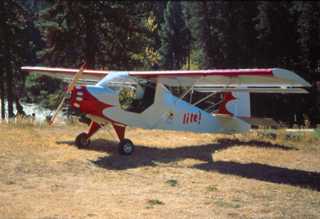
Although first appearing at Sun ‘n Fun in 1998, full kits were not delivered until late 1998 as time was taken to perfect SkyStar's first true ultralight airplane. The new Kitfox Lite is a true ultralight and fully complies with FAR 103 standards. The Kitfox heritage is clearly evident in the Kitfox Lite; it is easy to build and fun to fly. The Lite has standard 3-axis controls, highly effective flaperons and classic styling. The Lite has a useful load of up to 300 pounds and can accommodate a BRS parachute system. With a rate of climb of 700 fpm, a cruise speed of 55 mph and two-hour endurance, the Lite offers outstanding flying fun. Build time is less than 200 hours.
An entire chapter in this book is dedicated to flying the Kitfox Lite, so these comments will be kept to a minimum. Suffice to say, the Kitfox Lite is every bit a “real” airplane and requires “real” pilot skills. As a tailwheel airplane, the Lite is remarkably easy to take off and land, but tailwheel operating knowledge is recommended. The Kitfox Lite is a very low inertia airplane, and care must be taken to keep approach speeds high enough to have energy for a good flare to land. In short, flying the Kitfox Lite is about the most fun one can have in public. (Return to Top)
Kitfox Series 6 (Out Of Production)
SkyStar’s new management team introduced the Kitfox Series 6 in 2000 as the latest refinement of the Kitfox line of aircraft. The multiple versions of the Series 5 Kitfox were all rolled into a single airplane that possessed the most versatile features of all the Kitfox's. The Kitfox Series 6 has a useful load of up to 800 pounds and a range of over 700 miles, coupled with cruising speeds of over 120 mph. The factory’s Series 6 actually averaged 137 mph in the Sun ‘n Fun 100 Air Race in 2001, and that was with two folks on board, a bunch of cameras and crew meals!
The Series 6 could be configured as either a tri-gear or tailwheel airplane, and can be converted to either version after assembly is completed. Assembly times were significantly reduced, and the Series 6 accommodates more engine types than any other Kitfox. The look, feel and flight characteristics of the Kitfox Series 6 are like those of the most sophisticated, certified airplane, but none of the Kitfox adventure has been sacrificed.
All of the good flying qualities inherent to the Kitfox Series 5 are present in the Kitfox Series 6. The Series 6 has a heavy-duty landing gear system that improves soft and rough field ground handling. The Series 6 no longer used the bungee/tube landing gear that was standard on the Series 5, resulting in a more easily controlled airplane during rollout after a tailwheel landing. Like all Kitfox's, the Series 6 retains the ability to perform awesome forward slips and is an ideal airplane for short field operations. The Kitfox Series 6 has a refined flap system that allows the selection of two optimum flap positions. The first notch is used for takeoff and approach. while the second notch is generally reserved for landing. The tri-gear version of the Series 6 is very well balanced, and smooth takeoff and landing rotations are effortless. (Return to Top)
Kitfox Lite Squared (Out Of Production)
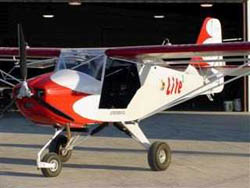
The popularity of the Kitfox Lite led to the demand for a two place, ultralight trainer with flight characteristics that are similar to SkyStar’s popular single place ultralight. A proven version of the Kitfox Classic 4 was packaged to meet this demand, resulting in the very FastBuild, Rotax 503 powered Kitfox Lite Squared. This well-proven design flies like the Lite, its single place counterpart, and offered the ability to upgrade to a variety of larger engines. SkyStar picked up on the success of the convertible Series 6, and equipped the Kitfox Lite Squared with a convertible landing gear system. It can be assembled as a tri-gear or tailwheel airplane and then changed at a later date. The Kitfox Lite Squared was sold as a very cost effective package, and can be operated as an ultralight, experimental or Sport Plane.
Flying-wise, the Kitfox Lite Squared is a trip “back to the future.” The flight characteristic assigned to the Kitfox Model 4-1200 is most applicable to the Lite Squared. This fun, agile airplane offers performance and a long-standing history of flying qualities that are well understood. The FAR 103 legal version of the Lite Squared is exceptionally docile and easy to fly. Tri-gear was available for those who wish to avoid the learning process required of a tailwheel airplane. The Kitfox Lite Squared package has been discontinued, but lives on as the Kitfox Classic 4. With the introduction of the Sport Pilot regulations, the Sport Plane, a design definition that is now rolled into the Kitfox Series 7, will replace the FAR 103 training plane (Return to Top)
Kitfox Series 7 (Still in production)
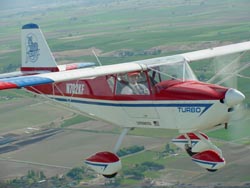
The Kitfox Series 7 introduces a variety of both major and subtle changes in the Kitfox history of ongoing product development. Most noteworthy is a variety of engine system enhancements that have resulted in an airplane that can cruise at over 150 mph, fly 700 miles non-stop, and heft a useful load of 700 pounds. Through use of the remarkable Rotax 914, turbo-charged engine, the Kitfox Series 7 has a service ceiling of 25,000 feet, meaning it can operate from any public use airport in the United States, without concern over runway length, field elevation or air temperature.
Flight control improvements have lowered the landing speed and reduced aileron induced yaw. The larger elevator and new manual trim system strengthen pitch authority and stability. The entire Rotax engine installation has been greatly simplified, resulting in a significant reduction in assembly time. This new installation also results in much improved windshield weatherproofing. Like the Kitfox Series 6, which has been replaced by the Series 7, convertible landing gear, folding wings, and many custom features are standard.
While many of the Series 7 performance improvements are achieved with the Rotax 914, Continental and Lycoming engines, in addition to the popular Rotax 912S, remain very popular engine choices. Most Series 7 improvements can be retrofitted to the Kitfox Series 5 and 6 (Return to Top)
Kitfox Sport (Out Of Production)
The Kitfox Sport package has been discontinued, but lives on as the Kitfox Series 7. The Kitfox Sport was a specially packaged version of the Kitfox Series 7 that was introduced into the marketplace to coincide with initial Sport Plane publicity distributed By the FAA and EAA. As time has passed, it has become clear that is not necessary to have this special package dedicated to the Sport Plane, as the standard Kitfox Series 7 meets all Sport Plane criteria.
The Kitfox Series 7 is perfectly suited for use by Sport Pilots, given the current definition of a Sport Plane as described in FAR 1. The Kitfox Series 7, when assembled light and certified to the gross weight authorized by Sport Plane regulations, provides the sport pilot with a safe, easy to fly airplane that is robust and simple to maintain. (Return to Top)
